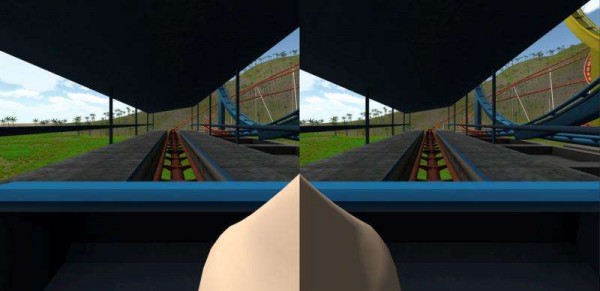Virtual Nose Reduces Simulator Sickness in Virtual Reality
| Sami Ghanmi | | May 14, 2015 10:28 AM EDT |
(Photo : David Whittinghill/Purdue University) Virtual Nose act as a visual reference
As more virtual reality technologies are beginning to make their way into the living room, a team of researchers from the Purdue University in the U.S. has been looking for ways to fight simulator sickness.
Simulator sickness, which is a subset of motion sickness according to a report, occurs when multiple senses are not in accord with one another. This means that when the sense of sight is not in accordance with the sense of hearing in the virtual world, confusion arises.
Like Us on Facebook
A virtual reality user, for example, may be riding a roller coaster through his "eyes" in the virtual world, but his body is telling him he's in his own living room.
The symptoms of simulator sickness include dizziness, a feeling of disorientation, and nausea.
Assistant Professor David Whittinghill said, "The problem is your perceptual system does not like it when the motion of your body and your visual system are out of synch."
"So if you see motion in your field of view you expect to be moving, and if you have motion in your eyes without motion in your vestibular system you get sick."
Researchers from the Department of Computer Graphics Technology at the Purdue University were able to solve this problem by adding a virtual nose in the virtual world.
They claim this natural method helped their test subjects stay much longer in virtual reality without getting sick. The researchers added that the virtual nose acts as a visual reference that moves along with the point of view of the observer.
This new method will also be very useful for virtual reality games, according to Whittinghill. He said, "You are constantly seeing your own nose. You tune it out, but it's still there, perhaps giving you a frame of reference to help ground you."
TagsVirtual Reality, How Virtual Nose Helps Reduce Simulator Sickness, Virtual World, VR, Simulator Sickness, Senses, Purdue University, Department of Computer Graphics Technology, Virtual Reality Games
©2015 Chinatopix All rights reserved. Do not reproduce without permission
EDITOR'S PICKS
-

Did the Trump administration just announce plans for a trade war with ‘hostile’ China and Russia?
-

US Senate passes Taiwan travel bill slammed by China
-

As Yan Sihong’s family grieves, here are other Chinese students who went missing abroad. Some have never been found
-

Beijing blasts Western critics who ‘smear China’ with the term sharp power
-

China Envoy Seeks to Defuse Tensions With U.S. as a Trade War Brews
-

Singapore's Deputy PM Provides Bitcoin Vote of Confidence Amid China's Blanket Bans
-

China warns investors over risks in overseas virtual currency trading
-

Chinese government most trustworthy: survey
-

Kashima Antlers On Course For Back-To-Back Titles
MOST POPULAR
LATEST NEWS
Zhou Yongkang: China's Former Security Chief Sentenced to Life in Prison

China's former Chief of the Ministry of Public Security, Zhou Yongkang, has been given a life sentence after he was found guilty of abusing his office, bribery and deliberately ... Full Article
TRENDING STORY

China Pork Prices Expected to Stabilize As The Supplies Recover

Elephone P9000 Smartphone is now on Sale on Amazon India

There's a Big Chance Cliffhangers Won't Still Be Resolved When Grey's Anatomy Season 13 Returns

Supreme Court Ruled on Samsung vs Apple Dispute for Patent Infringement

Microsoft Surface Pro 5 Rumors and Release Date: What is the Latest?










